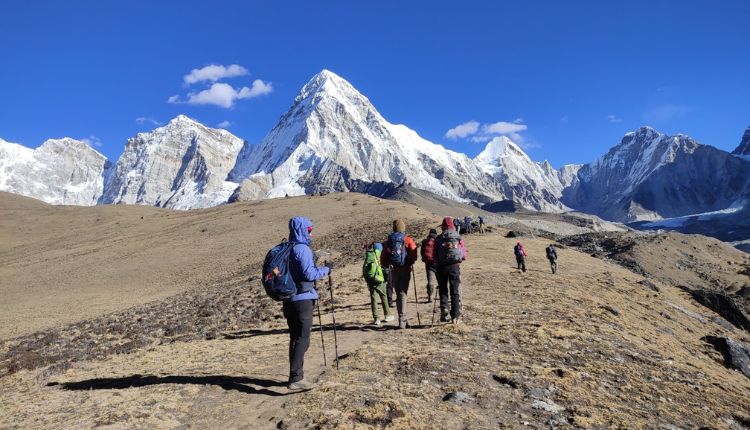over the world. It has various trekking routes that are situated at high elevations, most probably above 5,000 meters from the sea level.
Popular treks like the Everest Base Camp and Annapurna Base Camp are the perfect two examples of high-altitude trekking routes in Nepal. Because of this, adventure lover’s priority is visiting Nepal when it comes to trekking.
A high-altitude trek in Nepal provides the experience of a lifetime having some of the most stunning landscapes on the earth. Trekking in the Himalayas offers the chance to discover customized routes, untamed landscapes, and ancient villages settled away amongst towering peaks.
Every journey provides breathtaking views of snowcapped mountains, opportunities to interact with local peoples, and exploration of different flora and fauna.
On the other hand, proper planning, preparation, and training are necessary before starting a high-altitude trek in Nepal.
Training for the high-altitude trek in Nepal is crucial to ensuring a fun and safe trekking experience. High heights and rough terrain provide significant challenges that require both mental and Physical preparation.
Proper training helps to reduce the chance of getting altitude sickness in high elevations. For this acclimatization is essential to reduce oxygen levels at high altitudes and specific exercise or training enhances the body’s capacity to adopt these conditions.
Moreover, Trekkers can develop their strength, endurance, and cardiovascular fitness through training. They are also better properly equipped to handle the difficult terrain and hiking duration they will face on the excursion.
Furthermore, mental preparation is important since trekking at a high altitude can become emotionally taxing facing various factors like erratic weather, windy atmosphere, and remote areas.
Trekkers can lower their chance of injury, take in the breathtaking scenery, and completely immerse themselves in the cultural experience that high altitude in Nepal has by devoting time and energy to their preparation.
Some of the exercises such as cardiovascular fitness, strength training, and acclimatization are all essential training for high altitude treks in Nepal. Here are some steps you can follow to prepare effectively:
Cardiovascular Training
Cardiovascular training is an important part of getting ready for high-altitude treks in Nepal. It is imperative that you increase your cardiovascular endurance with aerobic exercise such as jogging, swimming, cycling, and hiking.
Cardio training will help you overcome the difficulties that come with hiking in high elevations. It’s crucial to increase the duration and intensity of your training or workout to improve stamina.
Try to be involved in three to four cardiovascular activity sessions a week, lasting half an hour or an hour each. Maintaining consistency is key because regular cardiovascular exercise not only strengthens your heart and lungs but also enhances your body’s capacity to use oxygen more effectively.
Cardiovascular practices also enable you to adapt to the lower oxygen levels found at the high elevation. Your training program will be more equipped to handle the rough terrain and long walking duration you’ll face on high altitude trek in Nepal if it includes cardiovascular activities.
Strength Training
Strength training is essential for a high-altitude trek in Nepal. It develops muscular endurance and strength, which might be required in challenging terrain, and carries a large bag pack.
It is imperative that you include a range of strength training activities in your exercise regimen, with an emphasis on strengthening the muscles in your upper body, core, and legs.
Legs exercises that target your quadriceps, which are essential for sustaining power and stability throughout extended periods of trekking, include squats, deadlifts, lunges, and step-ups.
Similarly, including the core exercises lowers the chance of injury on uneven terrain by improving stability and balance. Examples of these exercises are planks, Russian twists, and bicycle crunches.
Finally, upper body workouts like pushups pull-ups, and shoulder presses help to strengthen your arms, shoulders, and back. This workout is critical for carrying a backpack and utilizing the trekking poles.
You’ll increase your general strength and endurance as well as your comfort and performance on your high-altitude trek in Nepal by including strength-training activities in your training session.
Practice Trekking with a Loaded Backpack
Preparing for a high-altitude trek in Nepal requires practice traveling with a loaded bag pack. Practice going on a short trek near you with the full pack of equipment.
This allows you to replicate the weight and distribution of your pack, as well as helping you to overcome the obstacles you’ll face on the trail. Gradually increase the weight of your bag pack throughout the training sessions.
It is significant if you want to develop the strength and endurance needed to carry a heavy load over long distances.
In the beginning, start with a lesser load and increase progressively as your fitness training increases. This is to make sure you can keep good form and are comfortable while trekking.
Practicing trekking with a loaded back is a kind of exercise that helps build muscle in your shoulders, back, and legs. It also helps you get used to the load of carrying a backpack for a long period.
This will assist you modify your equipment and pack weight for your high-altitude trip in Nepal.
Mental Preparation
Mental preparation is a vital component of being ready for a high-altitude trip in Nepal. It entails preparing yourself for the wide range of challenges that come with trekking in such conditions, such as unpredictable weather, difficult terrain navigation, and extended hiking routes.
Having a positive mindset is essential because it lets you face the difficulties that might come with trekking with resiliency and resolve. This will enable you to face the difficulties and stay motivated throughout the journey.
Developing mental strength means accepting that challenges may come up but having confidence in your ability to tackle them ahead. Establishing reasonable objectives, focusing on the present moment, and visualizing successful results can all contribute to building a determined mental foundation for your journey.
It is preferable to prepare mentally yourself for the highs and lows of high-altitude trekking so you can completely enjoy the life-changing experience that the Nepalese Himalayas have to offer.
Altitude Acclimatization
Acclimatization is most important if you are planning to trek in high altitude in Nepal. Include the acclimatization day in your trekking itinerary to allow your body to adjust to the surroundings.
Ascend slowly, taking time to acclimatize at intermediate altitudes. Consider including acclimatization days in your trekking schedule, where you stay at the same altitude or ascend only a small distance to allow your body to adjust to the reduced oxygen levels.
Stay well hydrated throughout your trek and avoid alcohol and caffeine, as they can contribute to dehydration and worsen altitude sickness. Be mindful of the symptoms of altitude sickness, such as headaches, nausea, dizziness, and fatigue. If you experience severe symptoms, descend to a lower altitude immediately.
Seek Professional Guidance
Getting professional advice is an important part of getting ready for a high-altitude trek in Nepal. It entails taking into account the knowledge of licensed personal trainers or trekking guides with experience in high elevations.
These experts may provide personal coaching and suggestions to make sure your training plan fits both your fitness objectives and the demands of the hike.
Professional guidance or advice not only increases the efficacy of your training but also offers comfort and support, especially to individuals who are unfamiliar with high-altitude trekking.
You can approach your trip with confidence and preparedness by utilizing the skills of seasoned specialists, increasing your chances of having an enjoyable and safe journey in the Himalayas of Nepal.
Conclusion
It concludes that training makes it easier for travelers to handle the emotional and physical strains of the journey by developing mental resilience. Give priority to your health and body when training and trekking.
Don’t push yourself too harshly over your comfort zone while training for the trek in the Himalayas. Trekkers must adjust to the harsh environment and thin air of the high mountains to be safe and have fun on the journey.
Besides, the warm hospitality of Nepalese people and the companionship of fellow hikers enhanced the value of the trip.
Throughout the route, the trekkers experience the expansive vistas of snowcapped mountains, tranquil alpine meadows, Glacier Rivers, and pure alpine forests. It is like nature rewards with breathtaking scenery.
Enjoy the high-altitude trek in Nepal preparing with the proper training before the journey. It ensures an unforgettable experience that makes a lasting impression on every visitor.
Set your hiking gear, pack your bag, and embark on the trek in Nepal enjoying the top of the towering peak while soaking in the peace of the Himalayan nature.












